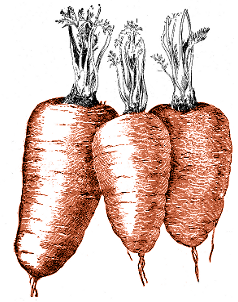Archive for the ‘Photobloggery’ category
Posted in Decorative, Photobloggery, The Old Garden In Bristol on Friday, November 18th 2011 (6.38 PM).
There haven’t, as you might have noticed, been that many posts on here in recent weeks. One reason for that, more than anything else, is the changing of the season and the changing of the timezone. When I get up in the morning, it’s dark. When I leave the house, it’s just about light – at the moment it will have been light for maybe 15 minutes, which of course will drop over the next 6 weeks. When I get home again, it’s dark, and it’s been solidly dark for well over an hour. Getting a job nearer home would help, but probably not very much, especially in the evenings.
However, there is one benefit to all this darkness. It means we can string solar-powered fairy lights all around the garden, and actually have darkness to see them in.
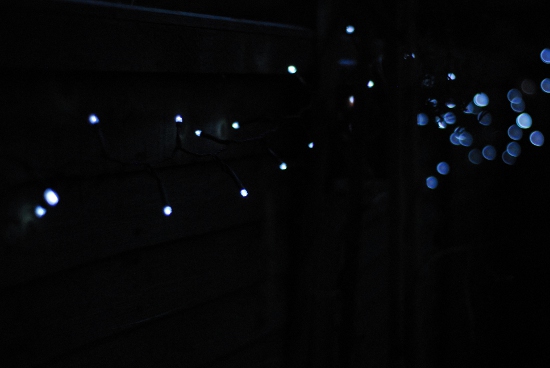
Despite the title of this post, they hardly let you garden in the dark. However, they do look good, when you look out of the kitchen windows, or stand in the middle of the garden late at night and whirl around looking at the lights and the stars.
Coincidentally, since I first drafted this entry – last week after we first put the lights up – I’ve read something else on night gardens: a post by Bristol-based gardening writer Lia Leendertz on the BBC gardening blog, about designing your garden to make it a pleasant place to spend a winter evening. Sadly we don’t have room for hedges or a fire pit, but I do like the idea of a telescope. Maybe I can make do with an SLR, my longest lens, and every teleconverter I can lay my hands on attached. Actually gardening at night will be a harder project to get going.
dark, darkness, fairy light, lighting, night, season, winter
Posted in Garden Diary, Photobloggery, The Old Garden In Bristol on Sunday, November 13th 2011 (5.04 PM).
This morning, I came across an interesting article in The Observer: for many plants and animals, spring seems to have come the wrong side of winter. Animals that should be hibernating are waking up again, and plants are still growing strongly and flowering, possibly because the weather has been unusually mild for the season. It prompted me to go outside into the garden, and have a look at the green bean plants, which we had left on their poles, just stems and pods and a few raggedy leaves, so that the beans we had left on the plant could develop and dry naturally ready for next year. Indeed, what did I find on the green beans? Lots of new buds, some of them just coming into flower. Here’s a photo I took this afternoon.
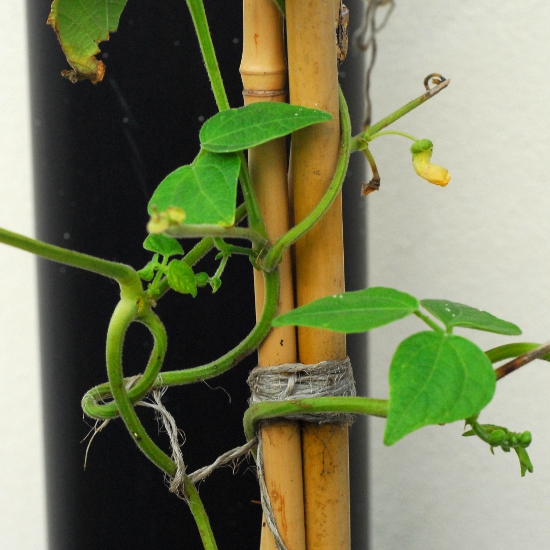
No doubt these flowers are not going to get much further; and they’re definitely not going to set fruit because we’ve not had any bees in the garden for a few weeks now. This weather doesn’t seem quite right, though.
There are a few things I did in the garden this week, largely while K was baking the Christmas cake. See, “just coming into flower” and “baking the Christmas cake” aren’t phrases that go well together at all if you’re north of the Equator. This is what got done:
- Pulling up the last of the radishes.
- Pruning some of the perennial herbs – the thymes, lavender, feverfew, and mint.
- Saving seed that is ready, or almost ready: runner beans, green beans, and coriander.
No doubt I am doing all this at entirely the wrong time of year, but – as far as the pruning was concerned, anyway – it felt like the right time to do it. The beans are for sowing next year; the coriander seeds are probably for the spice cupboard, and the pruned thyme branches were saved for the oven too.
autumn, bean, climate change, coriander, feverfew, green bean, lavender, mint, pruning, radish, runner bean, saving seed, season, seed, thyme
Posted in Experimentation, Garden Diary, Photobloggery, The Old Garden In Bristol on Wednesday, September 7th 2011 (10.14 PM).
Since the last “week in the garden” post, we have:
- Harvested the first green beans.
And, because we went away for a long weekend, that was about it. The garden didn’t take too kindly to us going away, either. Or, rather, it didn’t take too kindly to the weather: the combination of dry, hot days without us there for watering, followed by heavy rain, has not had good results. The spring onions have suffered in particular, and the runner beans have also had problems.
Back in the mists of time – well, August – before this blog had properly started, we sowed a few boxes of quick-growing things to give us some more produce into the autumn. As I mentioned then, I tried an experiment. All of the seeds were sowed into previously-used compost; and for each seed, I sowed one box into compost that had been used to grow peas, and one box into compost that hadn’t. It’s three-and-a-half weeks later now, and the results are pretty clear, at least for the radishes.
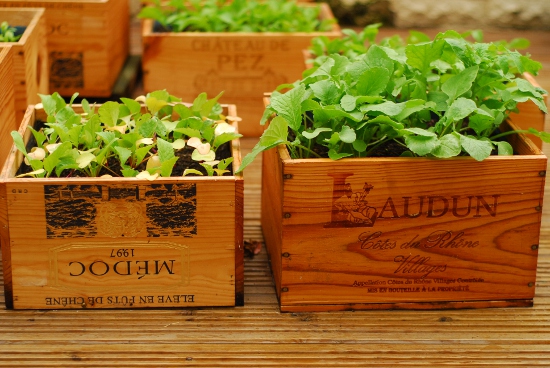
The pea compost is, I’m fairly sure, the one on the right. Science!
bean, compost, diary, experiment, french bean, green bean, nitrogen, pea, radish, scallion, science, spring onion, weather
Posted in Inspiration, Photobloggery on Saturday, September 3rd 2011 (11.38 AM).
As I’ve said already, despite the title, our garden isn’t a forest garden. It’s too small, for one thing. As you can see, it is a little patch which is ideally suited to being a container garden, but completely unsuited to becoming a lush, verdant, dappled-sunlit forest.
That doesn’t mean forest gardens aren’t inspirational, though. Or any garden which is mature enough to have a depth and richness to it, so long as its gardeners allow it to stretch itself and develop.
My first “inspiration” post, then, is a large, rambling National Trust garden one can easily get lost in: Kingston Lacy, Dorset. I’ve seen mixed reviews of it online; but the poor reviews didn’t really explain just what they didn’t like about it. Its formal gardens aren’t that special gardenwise, but they do have an unusually large amount, for Dorset, of Egyptian archaeology scattered through them. Further away from the house, though, the themed gardens are much more natural-feeling; whereas the formal garden could have been shipped in yesterday, the other gardens definitely feel grown-in, even though they have been largely restored in the past 30 years.
First, the walled Fern Garden, including a field mouse I managed to capture a quick snap of before it saw us and fled.
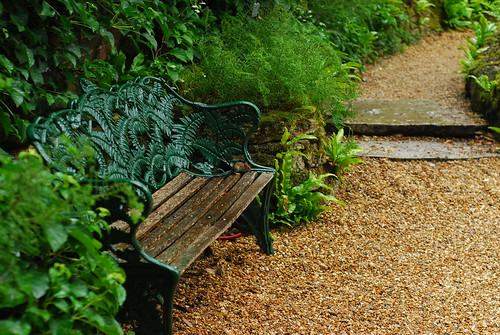
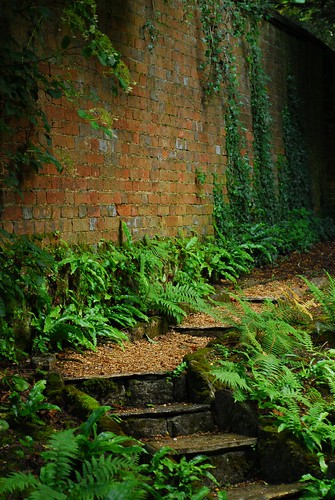
One of the largest parts of the gardens at Kingston Lacy is the Japanese garden, originally Edwardian, rebuilt in the early 90s. It includes several parts: a formal tea garden, a daisy maze overlooked by a bamboo shelter, and a more wooded area, blending in with the older trees fringing it. When we were visited, we were caught in a sudden summer downpour, so sheltered with our umbrellas, trying to take photos of the raindrops.
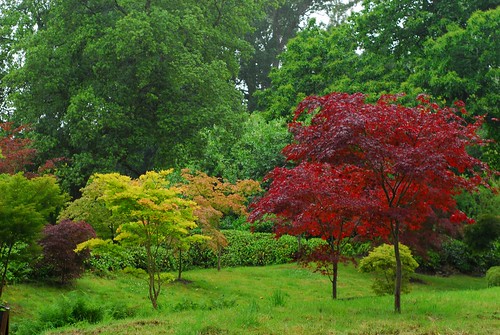
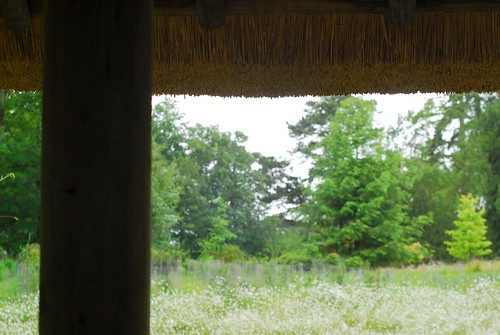
dorset, fern, fern garden, japan, japanese, japanese garden, kingston lacy, national trust, public garden, themed garden
Posted in Photobloggery, Planning, The Old Garden In Bristol on Sunday, August 28th 2011 (9.44 PM).
When we moved into Symbolic Towers, back in the summer of 2010, we were both novice gardeners. We were moving from a flat with a tiny little spit of decking in front of the living room, generally overtaken by brambles, so one of the things on the house-buying shopping list was: a garden that wouldn’t overwhelm us. Something that would give us some outside space we could use, but nothing that would need too much work to look after. We found: a little square of garden, almost all decked over, with a strip of bedding and a newly-erected trellis along the back.
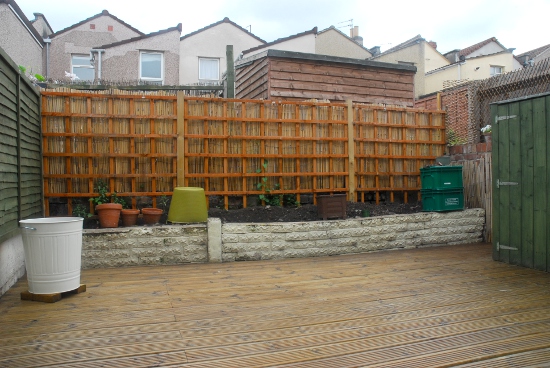
For the first 10 months after moving in, we did practically nothing to the garden, other than try to dig up the bindweed which quickly started poking itself up through the back bed. When spring came around, though, we decided it was time we started gardening. Time we started to make something of it.
Neither of us had ever designed a garden before, but we came up with a few basic principles.
- Our garden should be primarily an edible one; if we’re going to put all that work it, we wanted to get something to eat at the end of it.
- Above that, though, it should be organic and wildlife-friendly, up to the point that said wildlife start trying to eat the produce.
- “Wildlife” also does not extend to the cats from down the street who see the back bed and think “litter tray!”
- Pulling all that decking up would be far too much work. So our garden will be a container-based garden. Which does mean, for one thing, that if we decide we’ve planted things in the wrong places, we can move them all around later.
- We’d already discovered that the bed was full of bindweed rhizomes; digging those up, we discovered it was also full of broken glass and leylandii roots. So, for the first year, container gardening would be the thing, whilst we also dug up the bed completely, got rid of all the glass, bindweed, and lumps of coal, and put the soil back again.
That was back in April, nearly 5 months ago, and our embryo container garden has come a long way: potatoes, beans and various herbs all harvested, flowers bloomed and died, and our plans for next year’s season already starting to be formulated. I decided to start writing a blog about it for, well, several reasons. The main blog has been a bit moribund lately, and I thought having a well-defined topic might spur me into writing more. Moreover, I thought this blog could become something of a garden diary, helping us remember when we’d planted what, how long different plants had taken to develop, and compare things year-to-year. And, if nothing else, it can be a place for us to keep and discuss plans and ideas for future growth. It’s an extension of the original blog, and hopefully the name isn’t too confusing; our little patch of containers is very unlike a forest garden.
I’ll post again soon, with more introduction: a bit more about the situation and conditions we have to play with. For now, though, here’s a picture which, compared with the one above, shows how far we’ve managed to get in less than half a year.
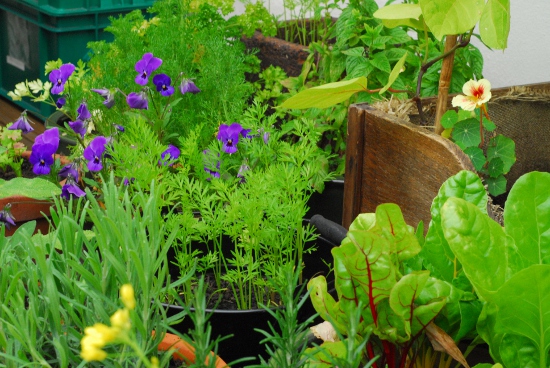
bindweed, blogging, introduction, overview
Posted in Photobloggery, The Old Garden In Bristol on Sunday, August 21st 2011 (5.15 PM).
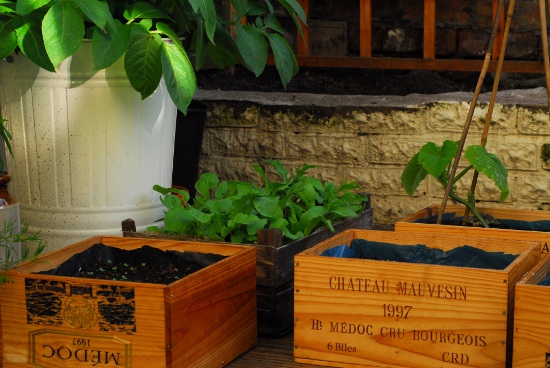
The back corner of the garden a couple of months back, when everything was still under the shadow of the potato leaves. Next year, the plan is for a rhubarb plant to take up the shade by the trellis.
containers, pattypan squash, plans, potato


